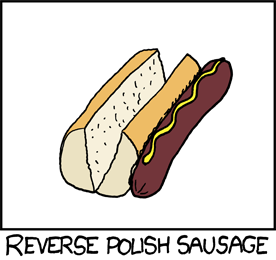hehehe
I laughed at this one twice - first, because it's terribly funny.
Second, because I know that a good portion of today's geeks won't have a clue.
It references Reverse Polish Notation (RPN) a style of entering calculations into a calculator popular with HP calculators (and others) many years ago. HP calcs still include that mode.
It's stack based, so you enter one number into the stack, then enter another number into the stack, then you press the operation you want to perform on the top two numbers.
In a 'regular' calculator you might enter:
4 + 5 =
And get the result 9
In an RPN calculator you enter
4 5 +
And the result goes back on the stack, showing 9.
In a sense, the equations are turning inside out:
(40 - 32)/9
becomes
40 32 - 9 /
Remember the result goes back on the stack, so the subtraction result ends up on the stack waiting for the 9 and / operation.
It's very, very, very simple to write a program that interprets RPN, which is one reason it was used years ago on many calculators. It's still used today partly out of habit for some people, and for others it's a more 'natural' way to think about a calculation (which is true for many types of calculations).
-Adam



